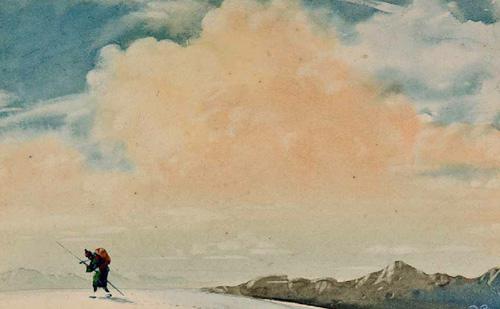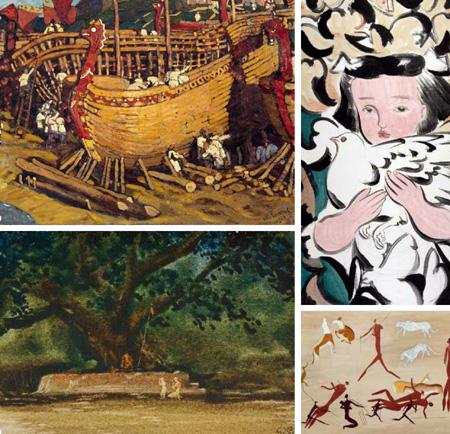BRICS Expands Into Art
2018-06-19byYiMei
by Yi Mei

As members of BRICS, Brazil, Russia, India, China, and South Africa represent five attentiongrabbing economies as well as the forces in the emerging global market that have risen in the 21st century. Their cooperation in the fields of trade and business are extensive and ongoing. Furthermore, as five countries boasting diverse and rich cultures, their cultural collaboration is also on the rise, as evidenced by the establishment of the BRICS Alliance of Art Museums and Galleries on April 12, 2018.
Artistic Alliance
To facilitate the growing international artistic cooperation accompanying increasing globalization, updating cooperation among BRICS art museums and galleries is essential. Exploring new cooperation under new international circumstances is a brand new challenge for all art museums and galleries, especially those in BRICS countries. In July 2017, representatives from Brazil, Russia, India, China and South Africa jointly signed a Letter of Intent on the Founding of the BRICS Alliance of Art Museums and Galleries during the second Meeting of BRICS Ministers of Culture, officially clarifying the intent of art museums in BRICS countries to set up a mechanism for multilateral cooperation. The alliance aims to promote mutual learning among cultures to boost cultural and artistic exchange among BRICS countries.
Between April 12 and 14, 2018, the National Art Museum of China(NAMOC) invited the directors of four other key national art organizations—the Iziko Museum of South Africa, the Brazilian Institute of Museums (IBRAM), the State Museum of Oriental Art in Moscow and the National Gallery of Modern Art in New Delhi—to join the first forum of the alliance, which signified the formal founding of the BRICS Alliance of Art Museums and Galleries. Wu Weishan, director of NAMOC, was elected the first secretary-general of the alliance with a term of five years.
“I am honored to serve in this role,” said Wu. “I am so glad for such a great platform to carry out cultural communication. I am convinced that our mutual trust, love and cooperation will be enhanced through art—the door to the heart. And we will be able to develop more genuine and deeper friendship.”
At the forum, directors of the five art institutions gave speeches, discussed the current development of art in BRICS countries, looked into the prospects of tapping into cultural synergy of the five countries and exchanged views on strengthening mutual understanding and friendly ties among them to deepen winwin cooperation through the alliance mechanism.
“We will launch a series of projects like artist exchanges, forums and joint exhibitions,” said Alexander Sedov, director-general of the State Museum of Oriental Art in Moscow, Russia. “I believe this will promote understanding between people in BRICS countries.”
The second forum of the alliance will be held next year in India, sponsored by the National Gallery of Modern Art. “BRICS countries feature drastically different cultures,”noted Adwaita Gadanayak, directorgeneral of the Indian museum, who is slated to serve as the executive secretary-general of the alliance next year. “Through exchange, we can understand each other more while keeping our own unique qualities.”
“While improving their domestic economies and living standards, governments and peoples of BRICS countries have remained open to cooperation for win-win results and mutual benefits, establishing profound multi-pronged and multi-dimensional cooperation ties,” remarked Wu. “The founding of the BRICS Alliance of Art Museums and Galleries establishes a working mechanism for in-depth exchange and interaction through displaying classical collections. It lays a solid foundation for deeper understanding of history and cultural traditions because we believe that all arts and thoughts are connected, and all cultures and arts should be shared by all mankind.”
Uniqueness and Convergence
Along with the forum,“Uniqueness and Convergence,”a special exhibition of the BRICS Alliance of Art Museums and Galleries, was held.
South Africa boasts a timehonored history of artistic expression dating back to the oldest known art in the world. This exhibition highlights and juxtaposes old and new, exposing how the traditional, spiritual and cultural aspects of a diverse and sometimes ancient South African society are included in modern and contemporary works.
“We create and feel art in hopes of tracking the emotions deep in the hearts of all nations because classical art paints the image of a country, a nation and an era,” elaborated Zhang Qing, Chinese curator of the exhibition. “The 61 works on display here reinforce our idea that beauty is the shared sun and inspiring spring of humankind. The power of life captured in the works helps us probe the core mental temperament of different cultures, so we can feel the glory and significance of humanity beyond time and space. ”
The Brazilian pieces in the exhibition showcased a glimpse not only of Brazils cultural diversity but also of the way Brazilian artists express their feelings in the contemporary world—the world in which BRICS came into existence and relevance as a group. Two of the works were especially interesting for the Chinese audience because they were “made in China.” Christus Nobrega created his piece during an artistic residence at Chinas Central Academy of Fine Arts. And Afonso Tostes continued his celebrated Work Room series in Beijing last year with instruments collected in Chinas Hebei Province.
“Amid expanding globalization, international artistic and cultural communication is increasingly important,” posited Wu Weishan. “As an important medium for international artistic dialogue, art museums and galleries play increasingly significant roles. Research on the methodology of cultural and artistic communication is a vital aspect of the mission of art museums and galleries as part of the public service system. We consider this exhibition just the beginning.”